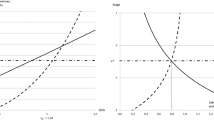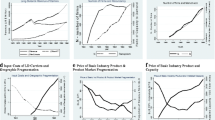Abstract
In this paper we offer a new economic explanation for the observed inter-industry differences in the size distribution of firms. Our empirical estimates based on three temporal (1982, 1987, and 1992) cross-sections of the four-digit US manufacturing industries indicate that increased market contestability, as signified by low sunk costs, tends to reduce the dispersion of firm sizes. These findings provide support for one of the key predictions of the theory of contestable markets: that market forces under contestability would tend to render any inefficient organization of the industry unsustainable and, consequently, tighten the distribution of firms around the optimum.
Similar content being viewed by others
References
Aslan A. (2008) Testing Gibrat’s law: Empirical evidence from panel unit root tests of Turkish firms. International Research Journal of Finance and Economics 16: 137–142
Baumol W. (1982) Contestable markets: An uprising in the theory of industry structure. American Economic Review 72(1): 1–15
Baumol W., Fischer D. (1978) Cost-minimizing number of firms and determination of industry structure. Quarterly Journal of Economics 92: 439–467
Baumol W., Panzar J., Willig R. (1982) Contestable markets and the theory of industry structure. Harcourt Brace Jovanovich, San Diego
Berry S., Reiss P. (2007) Empirical models of entry and market structure. In: Armstrong M., Porter R. (eds) Handbook of industrial organization. Elsevier, Netherlands
Bickel P. (1978) Using residuals robustly I: Tests for heteroscedasticity, nonlinearity. Annals of Statistics 6: 266–291
Cabral L. (1995) Sunk costs, firm size and firm growth. The Journal of Industrial Economics XLIII(2): 161–172
Cabral L., Ross T. (2008) Are sunk costs a barrier to entry?. Journal of Economics and Management Strategy 17(1): 97–112
Cefis E., Ciccarelli M., Orsenigo L. (2007) Testing Gibrat’s legacy: A Bayesian approach to study the growth of firms. Structural Change and Economic Dynamics 18(3): 348–369
Chen J., Lu W. (2003) Panel unit root tests of firm size and its growth. Applied Econometrics Letters 10(6): 343–345
Davies S., Lyons B. (1982) Seller concentration: The technological explanation and demand uncertainty. The Economic Journal 92: 903–919
de Wit G. (2005) Firm size distributions: An overview of steady-state distributions resulting from firm dynamics models. International Journal of Industrial Organization 23: 23–50
Del Monte A., Papagni E. (2003) R&D and the growth of firms: An empirical analysis of a panel of Italian firms. Research Policy 32(6): 1003–1014
Gabaix X. (1999) Zipf’s law for cities: An explanation. The Quarterly Journal of Economics 114(3): 739–767
Geroski P., Lazarova S., Urga G., Walters C. (2003) Are differences in firm size transitory or permanent?. Journal of Applied Econometrics 18(1): 47–59
Ghosal V. (1996) Does uncertainty influence the number of firms in an industry?. Economics Letters 50: 229–236
Ghosal, V. (2003a). Impact of uncertainty and sunk costs on firm survival and industry dynamics. Wissenschaftszentrum Berlin für Sozialforschung, Markets and Political Economy Working Paper No. SP II 2003-12. Retrieved from http://bibliothek.wzb.eu/pdf/2003/ii03-12.pdf.
Ghosal, V. (2003b). Firm and establishment volatility: The role of sunk costs, profit uncertainty and technological change. CESifo Working Paper No. 980. Retrieved from http://www.cesifo-group.de/DocCIDL/cesifo_wp980.pdf.
Ghosal, V. (2007). Small is beautiful but size matters: The asymmetric impact of uncertainty and sunk costs on small and large businesses. MPRA Paper No. 5461. Retrieved from http://mpra.ub.uni-muenchen.de/5461/1/MPRA_paper_5461.pdf.
Ghosal, V. (2009). The role played by sunk costs in real-options models. 10th CESifo Venice Summer Institute, 6-11 July 2009. Retrieved from http://www.cesifo-group.de/link/vsi09_ou_Ghosal.pdf.
Gibrat R. (1931) Les inegalites economiques. Sirey, Paris
Hagerman R., Senbet L. (1976) A test of accounting bias and market structure. Journal of Business 49: 509–514
Helfat C. (1994) Firm-specificity in corporate applied research and development. Organization Science 5(2): 173–184
Ijiri Y., Simon H. (1977) Skew distributions and the sizes of business firms. North-Holland, Amsterdam
Kalecki M. (1945) On the Gibrat distribution. Econometrica 13(2): 161–170
Kelly W. (1981) A generalized interpretation of the Herfindahl index. Southern Economic Journal 48(1): 0–57
Kessides I. (1986) Advertising, sunk costs, and barriers to entry. The Review of Economics and Statistics 68(1): 84–95
Kessides I. (1990) Towards a testable model of entry: a study of the US manufacturing industries. Economica 57: 219–238
Kwoka J., White L. (2001) The new industrial organization and small business. Small Business Economics 16(1): 21–30
Levy M., Solomon S. (1996) Power laws are logarithmic Boltzmann laws. International Journal of Modern Physics C7(04): 595–601
Lotti F., Santarelli E., Vivarelli M. (2009) Defending Gibrat’s law as a long-run regularity. Small Business Economics 32(1): 31–44
Malcai O., Biham O., Solomon S. (1999) Power-law distributions and Levy-stable intermittent fluctuations in stochastic systems of many autocatalytic elements. Physical Review E60(2): 1299–1303
Martin S. (1989) Sunk costs, financial markets, and contestability. European Economic Review 33: 089–1113
Martin, S. (2000). The theory of contestable markets. Purdue University. Retrieved from http://www.krannert.purdue.edu/faculty/smartin/aie2/contestbk.pdf.
Martin S. (2002) Advanced industrial economics. Blackwell, Malden, MA
O’Brien J., Folta T. (2009) Sunk costs, uncertainty and market exit: A real options perspective. Industrial and Corporate Change 18(5): 807–833
Oliveira B., Fortunato A. (2006) Testing Gibrat’s law: Empirical evidence from a panel of Portuguese firms. International Journal of the Economics of Business 13(1): 65–81
Scherer F., Ross D. (1990) Industrial market structure and economic performance, 3rd edn. Houghtn Mifflin, Boston
Schmalensee R. (1989) Inter-industry studies of structure and performance. In: Schmalensee R., Willig R. (eds) Handbook of industrial organization. Elsevier, Netherlands
Simon H. (1955) On a class of skew distribution functions. Biometrika 52: 425–440
Simon H. (1960) Some further notes on a class of skew distributions. Information and Control 3: 80–88
Simon H., Bonini C. (1958) The size distribution of business firms. American Economic Review 48(4): 607–617
Steindl J. (1965) Random processes and the growth of firms: A study of the Pareto law. Griffin and Company, London
Sutton J. (1997) Gibrat’s legacy. Journal of Economic Literature 35: 40–59
Sutton J. (1998) Technology and market structure. The MIT Press, Boston
Thomas L. (1996) Advertising sunk costs and credible spatial preemption. Strategic Management Journal 17(6): 481–498
White L. (1981) What has been happening to aggregate concentration in the United States. The Journal of Industrial Economics XXIX(3): 223–230
White L. (1982) The determinants of the relative importance of small business. The Review of Economics and Statistics 64(1): 42–49
White, L. (2002). Are giant companies taking over the US economy? Should we care? Milken Institute Review, Second Quarter, 60–68.
Wooldridge J. (2002) Econometric analysis of cross section and panel data. The MIT Press, Boston
Zmijewski M., Hagerman R. (1981) An income strategy approach to the positive theory of accounting standard setting/choice. Journal of Accounting and Economics 3: 129–149
Author information
Authors and Affiliations
Corresponding author
Rights and permissions
About this article
Cite this article
Kessides, I.N., Tang, L. Sunk Costs, Market Contestability, and the Size Distribution of Firms. Rev Ind Organ 37, 215–236 (2010). https://doi.org/10.1007/s11151-010-9265-5
Published:
Issue Date:
DOI: https://doi.org/10.1007/s11151-010-9265-5




